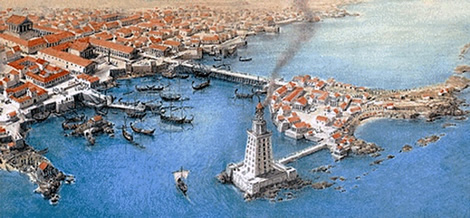 |
| Lighthouse of Alexandria |
Alexandria, also known by its Arabic name al-Iskandariyya, was named after Alexander the Great. Alexandria was built on the Mediterranean Sea coast of Egypt at the northwest edge of the Nile Delta. The city lies on a narrow land strip between the sea and Lake Mariut (Mareotis in Greek).
Alexander the Great founded the city in 331 b.c.e. He ordered Greek architect Dinocrates of Rhodes to build the city over the site of the old village of Rakhotis that was inhabited by fishermen and pirates. Alexander left the city under the charge of his general, Ptolemy (also known as Ptolemy I). The city would later become Alexander’s final resting place.
After it was built, Alexandria evolved into an important economic hub in the region. It began by taking over the trade of the city of Tyre whose economic prominence declined after an attack by Alexander. Alexandria soon surpassed Carthage as well, an ancient city that was the center of civilization in the Mediterranean.
  |
Although the city rose to great prominence under the Ptolemaic rulers during the Hellenistic period, it was soon surpassed by the city of Rome. During its peak Alexandria was the commercial center of the Mediterranean. Ships from Europe, the Arab lands, and India conducted active trade in Alexandria, and this contributed to its prosperity as a leading port in the Mediterranean Basin.
The inhabitants of Alexandria consisted mainly of Jews, Greeks, and Egyptians. The Egyptians provided the bulk of the labor force. Alexandria was not only a bastion of Hellenistic civilization; it occupied a very prominent position in Jewish history as well. The Greek translation of the Old Testament in Hebrew was first produced there. Known as the Septuagint, the Hebrew Bible took between 80 and 130 years to translate.
Thus, Alexandria was a major intellectual center in the Mediterranean. The city boasted two great libraries, with huge collections, one in a temple of Zeus, and the other in a museum. As early as the third century b.c.e., the libraries housed somewhere between 500,000 and 700,000 papyri (scrolls).
 |
| Alexandria harbour |
A university was built near the libraries, attracting renowned scholars to Alexandria. One of them was the great Greek mathematician Euclid, a master of geometry, and author of the famous work Elements.
After Cleopatra the queen of Egypt committed suicide in 32 b.c.e., the city of Alexandria came under the rule of Octavian, later known as Augustus, the first Roman emperor. Augustus installed a prefect in Alexandria, who governed the city in his name. Trade continued to flourish in the city under the Romans especially in the product of grain.
The city went into decline under the Romans. A Jewish revolt in 116 c.e. weakened the city. It resulted in the decimation of the Jewish population residing there. Nearly a century later in 215 c.e., for reasons that are unclear, the Roman emperor Caracalla decreed that all male inhabitants be massacred, perhaps as punishment.
   |
This further undermined the city’s importance in the region and was worsened by the rise of other important cultural, economic, and intellectual centers such as Constantinople, founded in 330 c.e. by Roman emperor Constantine the Great.
In both 638 and 646 c.e. Muslim Arabs invaded the city. During this time Cairo became another rival city. Alexandria soon weakened, and it was not resurrected until the 19th century.
 |
| Library of Alexandria |